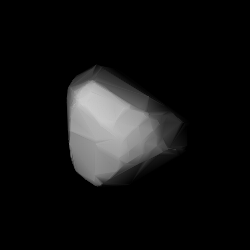 A lightcurve-derived shape model of Transylvania | |
| Discovery [1] | |
|---|---|
| Discovered by | G. Strommer |
| Discovery site | Konkoly Obs. |
| Discovery date | 27 August 1940 |
| Designations | |
| (1537) Transylvania | |
Named after | Transylvania [2] (region in Romania) |
| 1940 QA ·1940 QN A903 VB | |
| main-belt ·(outer) [3] | |
| Orbital characteristics [1] | |
| Epoch 4 September 2017 (JD 2458000.5) | |
| Uncertainty parameter 0 | |
| Observation arc | 113.42 yr (41,428 days) |
| Aphelion | 3.9677 AU |
| Perihelion | 2.1361 AU |
| 3.0519 AU | |
| Eccentricity | 0.3001 |
| 5.33 yr (1,947 days) | |
| 143.95° | |
| 0° 11m 5.64s / day | |
| Inclination | 3.8591° |
| 230.07° | |
| 148.20° | |
| Physical characteristics | |
| Dimensions | 13.60 km (derived) [3] 13.77±1.5 km [4] 17.48±1.16 km [5] 20.288±0.256 km [6] 20.29±0.26 km [6] 21.49±1.58 km [7] |
| 12 h [8] | |
| 0.05±0.00 [5] 0.052±0.006 [6] 0.067±0.010 [7] 0.1047 (derived) [3] 0.1619±0.041 [4] | |
| C [3] [9] | |
| 11.90 [7] [4] ·12.12±0.49 [9] ·12.30 [6] ·12.32 [5] ·12.4 [1] [3] | |
1537 Transylvania (provisional designation 1940 QA) is a carbonaceous asteroid and long-lost minor planet from the outer regions of the asteroid belt, approximately 17 kilometers in diameter. Discovered by Gyula Strommer in 1940, it was later named after region of Transylvania, where the discoverer was born. [10]